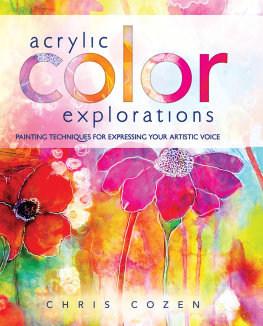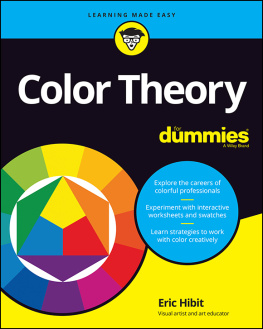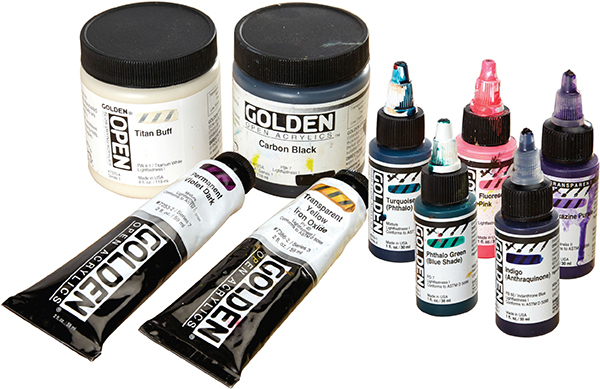Thank you for purchasing this Artist Network eBook.
Sign up for our newsletter and receive special offers, access to free content, and information on the latest new releases and must-have art resources! Plus, receive a coupon code to use on your first purchase from NorthLightShop.com for signing up.
or visit us online to sign up at
http://artistsnetwork.com/ebook-promo
Dedication
This book is dedicated to all of my students over the years. You are the inspiration for these pages. Your questions always lead me to discover things I dont yet know. Your enthusiasm for art created a proving ground for many new techniques over the years. Thank you for trusting me to guide you, for allowing me to share my love of color with you and for fearlessly jumping right in with me. Make me proud, go paint out loud!
Contents
CHAPTER ONE
CHAPTER TWO
CHAPTER THREE
CHAPTER FOUR
CHAPTER FIVE
Send in the Clowns
Chris Cozen
Acrylic and mixed media on Yupo
30" 22" (76cm 56cm)
Both warm and cool high-intensity colors were used to create an energetic environment for the clowns. Pattern and line add to the lively composition and provide visual direction.
WHAT YOU NEED
Surfaces
black gesso panel
canvas (optional)
Gelli plate print
painted surface
panels or boards
paper
Yupo surface
Pigments
Anthraquinone Blue
Aureolin Hue
Bone Black
Burnt Sienna
Burnt Umber
Burnt Umber Light
Carbon Black
Cerulean Blue
Cerulean Blue Deep
Cobalt Turquoise
Dioxazine Purple
Fluorescent Pink High Flow
Graphite Gray
Hansa Yellow
Hansa Yellow Light
Hansa Yellow Medium
Hansa Yellow Opaque
Indian Yellow Hue
Interference Blue
Iridescent Gold
Iridescent Gold Deep
Iridescent Pearl
Iridescent Stainless Steel
Magenta
Mars Yellow
Micaceous Iron Oxide
Naphthol Red Light
Naphthol Red Light High Flow
Naphthol Red Medium
Naples Yellow Hue
Neutral Gray N5
Paynes Gray
Permanent Violet Dark
Phthalo Blue
Phthalo Blue (Green Shade)
Phthalo Green
Phthalo Green (Blue Shade)
Phthalo Green (Yellow Shade)
Pyrrole Red
Prussian Blue Hue
Quinacridone Nickel Azo
Quinacridone Nickel Azo Gold
Quinacridone Magenta
Raw Umber
Red Oxide
Sap Green Hue
Teal
Titan Buff
Titanium White
Transparent Pyrrole Orange
Transparent Red Iron Oxide
Turquoise
Turquoise Phthalo
Ultramarine Blue
Yellow Ochre
Brushes
brushes, assorted
fine-tipped brush
pointed, short bristle brush
small flat brush
Other Supplies
Acrylic Glazing Liquid
Acrylic Ground for Pastels
acrylic skins (optional)
alcohol
assorted papers
brayer
bubble wrap
Catalyst tool
Coarse Molding Paste
color wheel
comb or carving tool with teeth
deli sheets
dropper or cotton swab
ephemera: maps, pages, vintage stamps
Fluid Matte Medium
gel medium
Gelli plate
Glass Bead Gel
glazing liquid
knitting needle, chopstick or pointed tool
Light Molding Paste
makeup sponge
mark-making tool
Origami Mesh paper
painted panel
palette knife
palette paper or mixing surface
papers, assorted
pencil
piece of art
rigid surface covered in plastic
rubber tool or comb
scissors
scraper, rubber
scratching tool
Soft Gel (Matte)
sponge
spray bottle of water
stamp, rubber
stencils
straw
white pen or chalk
Introduction
I love color and I want you to love it too. There is no need to spend your life in the limited company of a few colors or to fear making sound color choices. There is a world of color information waiting for you to explore that will expand your knowledge, give you color confidence and bring new dimensions to your own artful practices.
In his book On the Road, Jack Kerouac wrote, Soon it got dusk, a grapy dusk, a purple dusk over tangerine groves and long melon fields; the sun the color of pressed grapes, slashed with burgundy red, the fields the color of love and Spanish mysteries. When I read that line I wanted to jump up and paint it. It spoke to me in color. Reading the words allowed my mind to see what he was writing. Color vibrates, it resonates, clashes and converses. Color conveys emotion from happiness and joy all the way through sadness and remorse.
As a painter and a teacher, I want to know as much as I possibly can about color. I want to understand how to make the most of paints and pigments and the relationships between colors. The best and most direct way to learn what you need to about color is to get out your paints and begin to experience the voices of the pigments. The more you experiment, test, push, mix and adjust, the more you will learn.
When I gave myself permission to make color mistakes, I learned to be fearless about color. Becoming fearless about color gave me a certain freedom in my work as well as the confidence to explore color without reservation. As a result, when I do make mistakes, I now understand how to make adjustments before I veer too far off course. There is so much to understand about how to utilize the many voices of color, how to manage and adjust it, how to fully utilize all the nuances. In this book I have collected color-mixing recipes and exercises, lessons and experiences to share with you. I hope they will help you to become fearless about color as well.
This book is also a guide to understanding how color speaks. Together we will look at the calm and collected groups of colors, explore the polar opposites and learn how to create nuance and subtlety. We will push past the color wheel and open up color conversations that range from whispers to shouts. There will be opportunities for you to try new ways of working with colors through color-mixing and color-modifying exercises, and pattern development in both paint and mixed-media applications.
I will introduce you to various artists, both established and emerging, whose work will emphasize a color lesson or a particular application of color. I hope their work will inspire and enthuse you to try different techniques, color combinations or styles of painting.










